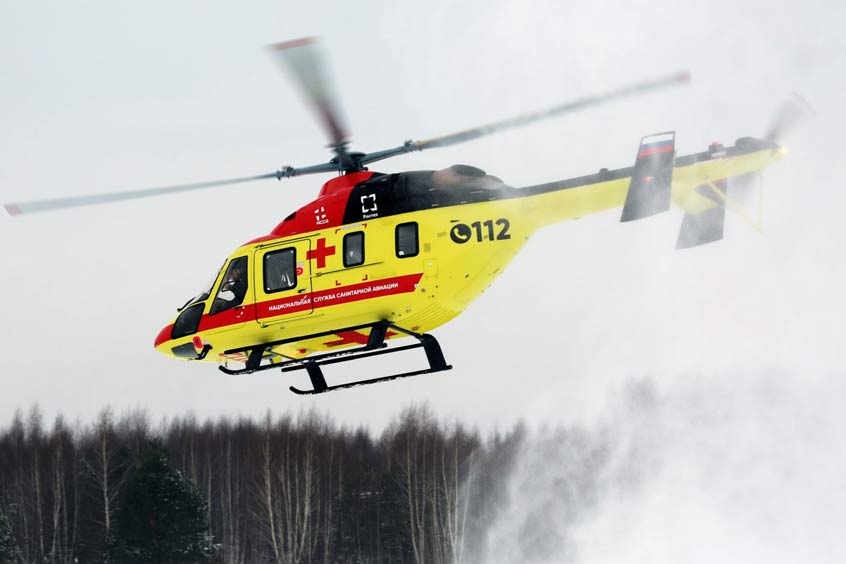Why visit ACE ’25?



The Kazan Helicopter Plant (KHP), a division of Russian Helicopters, has received approval from Russia's Federal Air Transport Agency (FATA) to equip the Ansat helicopter with an external sling and an additional fuel tank. The 195 litre tank allows operators to increase the flight range by 140 km and the external sling increases MTOW from 3,600 to 3,800 kg, and means operators are now able to transport up to one ton of cargo on Ansat fire fighting missions.
During sling tests, the helicopter climbed to an altitude of 3.7 km, having 600 kg of cargo overboard. At the same time, its speed was 180 km/h.
The Ansat can be used to extinguish fires with a spillway device, which is attached to the external sling and does not affect the design features of the helicopter. The fire extinguishing system has already successfully passed a series of tests carried out by specialists from KHP’s flight test complex.
In addition, the FATA has certified the installation of a special ‘heel’ on the runners of the Ansat chassis, the so-called bear paws that provide pilots with the ability to land on soft ground.
"Our task is to make the Ansat a universal helicopter capable of performing a wide range of tasks. The expansion of optional solutions increases, among other things, the Ansat's search and rescue functions, which is important for customers,” says Russian Helicopters general director Nikolay Kolesov. “In 2020, the first Ansat expanded the aviation fleet of the North-West Aviation Rescue Centre, and we expect that its new capabilities will become the basis for further building of cooperation with the Russian Emergencies Ministry.”
FATA has already certified a number of optional solutions that expand the possibilities of using the Ansat for search and rescue missions, in particular the use of a searchlight that can be used together with an onboard winch. In April 2021, Kazan Helicopters received approval for the installation of an onboard boom with a winch, so operators could safely lift on board and lower people and goods weighing up to 272 kg. The side boom is also indispensable for search and rescue operations and allows for loading and unloading operations in hover mode.
In addition, within the framework of the contract for the supply of helicopters for Russia's National Air Ambulance Service, the installation of domestic LED controlled FSD-134M search and landing lights developed by the Scientific Research Institute of Micropribors has been certified.
KHP completed certification tests of the additional fuel tank in June 2021; the accident resistance of additional fuel equipment was proved when it was dropped from a height of over 15m. The additional tank is designed to increase the flight range of a helicopter, especially useful in carrying out a medical evacuation of a patient from remote areas.
"Today, a large scale modernisation of the serially produced Ansat helicopter is underway. At the same time, work is underway to create an improved version, the Ansat-M. For both projects, work aimed at increasing the range of the helicopter is of great importance, as its results will improve the flight characteristics of the upgraded Ansat and its new model," adds Kolesov. "Certification tests of the main fuel system with increased capacity have already been carried out and the declared range of 640 kilometres has been confirmed. Taking into account the use of an additional fuel tank, the total flight range of the Ansat will be 645 km, and the Ansat-M up to 780 km."
An additional fuel tank can be placed in both the passenger and medevac versions of the Ansat. The device will be installed inside the helicopter's passenger cabin. It will also be possible to equip helicopters that are already in operation with an additional tank with only minor modifications.
Finally, the company has completed the next stage of certification work for the increased Ansat capabilities, including a complex of fatigue and equivalent cyclic tests of the assemblies.
"The increase in the capabilities of the Ansat helicopter's assemblies significantly affects the decrease in the cost of its flight hours. Work in this direction has been carried out systematically and in stages for several years, which undoubtedly increases its competitiveness," says Kolesov.
The capability of the tail boom was increased from 3,000 to 4,000 hours and that of the main rotor hub assemblies from 4,000 to 5,000 hours; the service life before the first overhaul of the main gearbox VR-23A and connecting shafts SV-23 went up from 1,750 up to 2,000 hours, and from 3,500 to 4,000 hours.
In total, 10 approvals for major changes in the standard Ansat design were received in 2021. KHP plans include a further gradual increase in the capabilities and service life of the helicopter and its assemblies, both of its own production and of purchased components. In 2022, work will be undertaken to upgrade the vibration dampers, skid landing gear, tail boom and a number of other units and components.